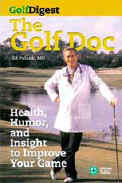“The Golf Doc” can help you
July 7, 2000
Who would have thought that a book of medical advice would be fun to read?
Dr. Ed Palank managed to do it, with The Golf Doc: Health, Humor, and Insight to Improve Your Game, (Jones & Bartlett, paperback, $19.95 SRP).
Palank is a New England cardiologist, a contributor to Golf Digest magazine, and an occasional guest on The Golf Channel. His medical background made him more than qualified to produce this book. His experience with golf publications and media also made him appreciate the need to keep things simple but informative.
As one might expect, Palank is a fervent advocate for the benefits of walking while playing golf. He readily accepts that for golfers with special needs, the golf cart is absolutely necessary. Nonetheless, from the very first chapter Palank explains why and how walking the course will benefit most golfers, both for their health and their play.
From there the chapters are devoted to specific issues. Each chapter can be read as a basic health care reference guide, without reading the other segments. For example, following Palank’s tips in the chapter on skin care should help many golfers avoid skin cancers and other problems. Chapter 19’s discussion on diabetes and golf is a real bonus for those who either live with the condition or have golfing relatives who do.
One relatively new medical innovation is given its own chapter, as one might expect from a cardiologist. Automated External Defibrillators (AED) can perform an initial evaluation of a golfer apparently in cardiac distress. The machines then deliver an appropriate electric shock.
AEDs are not costly. They can be placed in strategic locations throughout a golf course, and staff can be readily trained to use them while awaiting the paramedics. Palank also gives readers a handy tutorial in Cardiac Pulmonary Resuscitation (CPR).
In addition to some funny cartoons, Palank also makes use of great photography. Some shots are great mood setters. Others are good teaching devices, such as those illustrating several strengthening exercises for women.
The Links to Experience sidebars are also good instructional tools. Typically these segments relate a story about a particular golfer and a single health condition, such as “golfer’s rib,” or “first tee angina.” This situation is in fact a sign of coronary blockage that needs attention.
In the example Palank gave, the amateur underwent a balloon angioplasty. He was able to return to golf soon thereafter. The fact that the golfer returned to the sport he loved made it a good example for many men. Unfortunately, men are more likely to avoid seeking medical attention because it might crimp their lifestyle.
Club professionals should keep a copy of this book handy in their shops. It should also have a place in each locker room and/or club library. The Quick Emergency Index at the back of the book will be really helpful.
Palank should be proud of his accomplishment. If his book receives wide distribution, Palank will have performed a valuable service for thousands of golfers and their families.
Short Putts
Congratulations to PGA Club Pro Pete Oakley of The Rookery for his fine showing under difficult circumstances at this year’s United States Senior Open at Saucon Valley’s Old Course, near Bethlehem, Pennsylvania. Oakley’s mother died in Florida just as the tournament began. Oakley continued play, made the cut, and was joined by his family for his 41st place finish.
Carole Bradt of Shawnee Country Club won (she says stole) first place at the Pepsi-Cola Invitational at Green Hill Country Club on June 21-22. Her handicap made its usual springtime creep-up and Bradt won the third flight category.
In other local club action, Shawnee Country Club held a Ladies Day Net tournament on June 22. Jean Murphy took first, Alice Daino was second, and Barbara Keck finished in third place.


